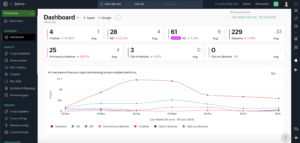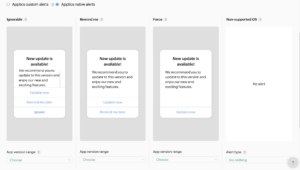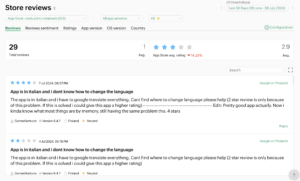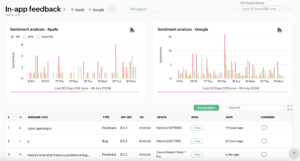 An Intellyx BrainBlog Product Review by Jason English for Zoho
An Intellyx BrainBlog Product Review by Jason English for Zoho
The mobile app craze began when iPhones and Android devices started appearing in everyone’s hands in the early 2010s. Users downloaded millions of popular games and social media apps through Apple App Store and Google Play.
Mobile apps are the de facto application delivery platform today—with well over 200 billion apps downloaded annually, you don’t need an analyst to tell you that. Engage your customers with a mobile app, or face a diminished future.
Building native mobile apps for an array of devices is not the same as building web applications and services. Developers use mobile frameworks like React, Flutter or Swift, but they also need a dedicated set of delivery, testing, observability, feedback and interaction design tools built specifically for mobile apps.
I caught a demo of Zoho Apptics at the Zoholics user conference—a native mobile app analytics, testing and feature delivery platform that goes beyond crash reports to meet customer needs while minimizing administrative overhead.
The challenge of app burnout
App burnout is an unfortunate hangover of the mobile revolution. Our smartphones are getting clogged with apps, many of which we use once or twice, then never again. As a result, we have far too many quickly produced and poorly validated apps taking up limited screen space.
Further complicating matters, mobile apps can fail to deliver the experiences users expect. Business apps are often not as useful or feature-rich as their desktop and website counterparts. Social media apps track our usage data to take us down algorithmically generated rabbit holes. Our games and retail apps can constantly push purchases and serve inescapable ads that never end.
More importantly, mission critical business scenarios may fail to execute consistently across mobile devices. Apps crash, or fail to update. Orders get stuck. User interruptions for new authentications, reviews and third-party information gathering are becoming endemic.
While there are already mature tools on the market for code-level scanning and debugging during development, and functional testing and crash reports in pre- and post-delivery onto devices, we need to pay attention to the many user touchpoints that can contribute to app burnout.
Helping Zoho move to hybrid application visibility
Growing wildly from its base of around a million active SaaS users in 2008, now has more than 100 million users working within its well-known suite of 70+ apps under the Zoho One platform umbrella, doing everything from CRM, to accounting, to low-code app creation within a browser, and increasingly, within native mobile apps.
“With the diverse breadth and depth of products that we have at Zoho, our development teams started using Apptics internally around 2017 to gain the usage stats and as a crash analytics tool to understand the health of our mobile apps,” said Priyanka V., Product Marketing Manager of Zoho Apptics.

“Now, with our customers’ demand for hybrid application development, we are supporting insights on everything from desktop apps like Zoho Trident, SDKs for mobile apps on Android and iOS, and even Apple watchOS, and the support for web apps in JS is on the way.”
While Zoho Apptics provides a metrics dashboard and alerting that resembles other well-known observability and testing tools, its low-code, ridealong approach also contains several mobile app-specific capabilities to privately gauge customer sentiment and adjust user-facing features.
Measure with user consent first
In-app monitoring is a particularly tricky aspect of mobile app development to build. Obviously, developers would like to gain insight into real-world user activity, where simulated, happy-path testing is inadequate. But simply inserting a few extra lines of legalese into a lengthy user acceptance agreement isn’t gonna cut it if later ‘spyware’ legal concerns arise.
Each time an app reports customer input back to the publisher, whether for performance testing, support reasons, account management, or user feedback purposes, developers need to write user consent code that respects the privacy laws of regional jurisdictions, as well as fitting within the guidelines of each app store.
Zoho had a built-in advantage here because they have had a privacy-first approach to their customer data all along, so any passive feedback coming through Apptics from an aggregated user base is already anonymized and useless to third parties.
“Right now when you download any Zoho application, the first screen that will pop up asks you to go to your settings and privacy screens to figure out if you want to share usage stats, or your email address, or to enable crash reporting, and if not, Apptics won’t collect any data,” said Priyanka.

Zoho Apptics makes this same granular-level consent control available for application publishers, so there’s no need to write custom code to inherit customizable policies.
If users choose it, Apptics offers pre-built user widgets for things like in-app feedback and bug reporting—for instance, give the phone a single ‘shake’ upon an error or when you encounter any bug, and Apptics will ask them if they would like to send a screenshot with masked personal data. This feedback can then be shared with your Customer support team using the Zoho Desk or Zendesk integrations.
Notably, if you want to resell user targeting data to advertisers or algorithmically market products based on in-app session data, Zoho will tell you to look elsewhere for that!
Cross-platform publishing and updates
As users, we’re all familiar with the constant drumbeat of updates that happen within our frequently used apps. Sometimes they are just data settings that are quietly downloaded in the background. Or they can be ‘nagware’ reminders within the app asking users to visit the app store. Sometimes they can be mandatory and interrupt attempts to use the app again without the update.
App development teams would much rather spend time building and improving customer-facing functionality than writing custom API code to package and publish multiple updates to app stores and marketplaces. Zoho Apptics brings cross-platform updates into a combined low-code model that automates publishing and circulates user notifications.
“Let’s say if your app has an incompatibility with iOS 11, you can just click to select update criteria and force a mandatory update to all of those users on the App Store. Or if you have a cosmetic update that won’t affect performance for a while, you can publish an ignorable reminder to all users without having to customize the update for Google Play API and Apple App Store APIs,” said Priyanka.
Regional-specific and language-specific updates can also be selected through the same module, and third-party marketplaces and repositories addressed through the same API-based model with an initial adapter configuration, which is particularly useful for privately updating apps among a workforce.
Closing the feedback loop

Positive and negative ratings and reviews will make or break any app, so it is critical for development teams to monitor and follow up on these critical points of feedback.
“When you download a popular app, you will see thousands of reviews. And if you own an app that goes viral, it would be almost impossible to respond to all the incoming reviews manually within each app store,” said Priyanka.
“Apptics uses APIs to fetch review data directly from Google Play and the Apple App Store and display it in a single console view, so you can figure out the overall customer sentiment and respond to reviews individually or as groups across marketplaces, or generate replies using the built-in Zia conversational AI integration.
App publishers try to get ahead of negative feedback by periodically requesting reviews from end users, but this requires a gentle touch. Ask too often, or ask at an inopportune time, and risk getting less favorable reviews.
Further complicating matters, each marketplace has guidelines for appropriate review behaviors. For instance, Apple App Store only allows up to 3 review requests within a 365-day period.

Zoho Apptics displays detailed views of aggregated user flows and event funnels, so app owners can pick the most opportune times to ‘pop the question’ for a review—often at the end of a completed sequence of tasks or a successful transaction, when user sentiment is predictably higher.
The Intellyx Take
If necessity is the mother of invention, then it’s been fascinating to watch how Zoho Apptics was developed from the need for an internal developer APM and testing utility into a hybrid, feature-driven application testing and delivery tool that eases many underserved problems in mobile app development.
There are many other observability, testing, and service management platforms on the market, which could benefit from another unique source of truth and event-based data. Zoho Apptics sets itself apart with its unique ability to take publishing and marketing tasks off of the plates of development teams.
©2024 Intellyx B.V. Intellyx is editorially responsible for this document. At the time of writing, Zoho is an Intellyx subscriber. None of the other organizations mentioned here are Intellyx customers. No AI bots were used to write this content. Image sources: Zoho Apptics (screenshots), and Adobe Image Express (art).



